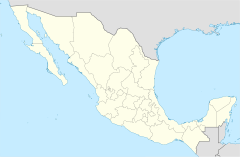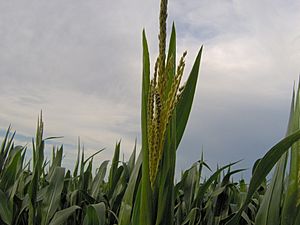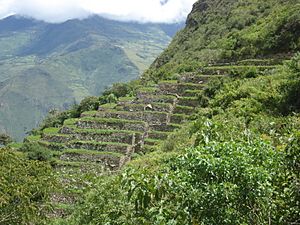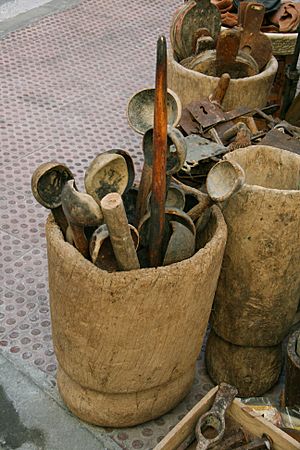Monte Negro, Oaxaca facts for kids
Quick facts for kids
Monte Negro
|
|
|---|---|
|
Municipality and town
|
|
| Country | |
| State | Oaxaca |
| Area | |
| • Total | 547.33 km2 (211.33 sq mi) |
| Elevation | 100 m (300 ft) |
| Population | |
| • Total | 1,876 |
| Time zone | UTC-6 (Central Standard Time) |
| • Summer (DST) | UTC-5 (Central Daylight Time) |
| Postal code |
68920
|
| Area code(s) | 954 |
Monte Negro is an ancient mountain-top town that existed around 200 BC. About 2,900 people lived there a long, long time ago! This town wasn't used for very long because there weren't many smaller villages around it, only farming terraces on the mountain. Monte Negro had unique buildings, especially with its columns and structures that were never taller than six meters (about 20 feet). Many cool pottery pieces and designs found here came from a nearby important city called Monte Alban.
Contents
Ancient Buildings and Design
The buildings found at Monte Negro were mostly rectangular platforms. These platforms were often built around small open areas called patios. Some buildings were lined up along streets that were over 100 meters (about 330 feet) long. These streets ran east-west, and other streets ran north-south, making the town look like an "L" shape.
The biggest open space in Monte Negro was a plaza, about 20 meters by 20 meters (65 by 65 feet). A temple and other important buildings surrounded this plaza. The bases of these buildings were made from limestone blocks and rubble. They also had special column bases.
Walls and Columns
The walls of the buildings had strong stone foundations. On top of these, people used adobe blocks, which are like sun-dried mud bricks. Columns stood along the bases of the buildings. These columns helped to hold up roofs made of thatch (like straw).
The columns are a very special part of Monte Negro's architecture. They were made from unevenly cut stones stacked on top of each other. The inside of the columns was filled with rubble. These columns were about 3 meters (10 feet) tall. They were used in both important homes and temples. To get to the adobe structures on top of the platforms, people used stone stairways.
Homes and Temples
Over time, the homes in Monte Negro became more private and looked more alike. The way houses were built close to temples suggests that people started combining their homes with religious areas. This kind of design was later seen in the bigger city of Monte Alban.
Important people's homes were easy to spot. They had more stone carvings and were built closer to the temples and plazas. Temples in Monte Negro varied in size and how they were designed inside. However, each temple was built on top of stone platforms with column supports and stairways. They shared some similarities with buildings at Monte Alban.
Ancient Burials
Archaeologists found tombs that show important people lived in Monte Negro. Some of these leaders were buried inside temple platforms. They were buried with many ceramic pots, shiny shell ornaments, and jade ear decorations. Some skulls found in burials were shaped differently, which was a sign of being an important person. Some tombs were made of adobe blocks with stone or wood roofs. Other burials were simply pits in the ground.
Farming and Food
The people of Monte Negro used a special farming method called lama-bordo. This system involved building terraces, which are like giant steps on the mountainside. It was a lot of hard work, but it helped support the community.
The walls of these terraces were made of stone and were rebuilt over many years. This rebuilding process created deep, rich soil that was great for growing crops. The terraces stretched down the mountainside and into the valley floor, about 500 meters (1,640 feet) below. The main crop grown on these terraces was corn. However, the high elevation of the terraces meant that frost could sometimes limit the growing season.
Ancient Pottery
Monte Negro has pottery that is very similar to the pottery found at Monte Alban. Scientists have used radiocarbon dating to figure out how old things are. This dating suggests that Monte Negro might even be older than Monte Alban!
Archaeologists found different types of pottery. There was "tanware," which included jars, cucharas (spoons), comales (flat griddles for making tortillas), and bowls. These pieces often had red and black designs painted on them. They also found "grayware" pottery, also decorated with red and black paint. This grayware likely came from the Oaxaca region.
Later pottery, from a time period called the Post-classic era, was also found on the terraces. This included "creamware" bowls and jars. Creamware has a unique yellow to yellow-orange color.





